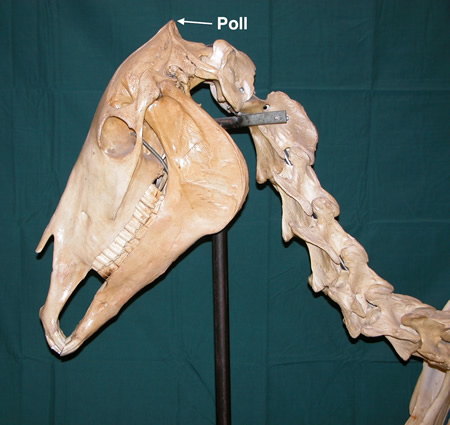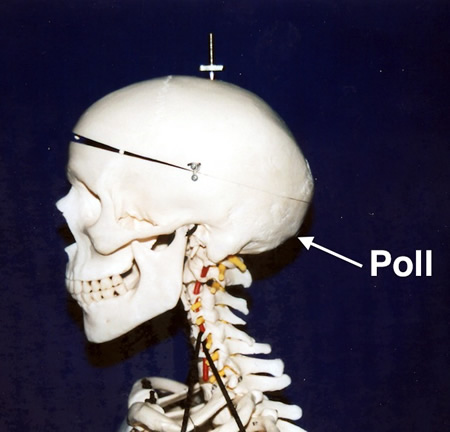Have you ever considered how much your head weighs? Or how much your horse’s head weighs? Well this and other interesting facts might surprise you when you start to compare your head to your horse’s head.
Your head weighs about 8 –15 lbs or approximately 8% of your total bodyweight. If you have ever gone bowling, the ball you used weighed about as much as your head. That is pretty amazing considering you carry your bowling ball around on top of your spine all day long and very rarely notice it. That’s because our nervous system, muscles and skeleton are designed to carry a 10 lb bowling ball around on top of our spine. If you have ever had whiplash, you know just how heavy your head is because you can no longer support it effortlessly.
By comparison, a 1000 lb horse’s head weighs 40 lbs or 4% of their total body weight. His head is also at the end of his spine but it hangs horizontally out from the body. This orientation means that gravity exerts a lot more influence on the horse’s head than on ours.

If we stand with good posture, the force of gravity is transmitted down through our skeleton to the ground. You might remember from physics class that the ground exerts an equal and opposite force called a “ground reaction force” pushing back up on us. The force of gravity has a greater effect on the horse’s ability to carry his head because his head hangs off the front of the body, not over his feet. This may be why the horse’s poll (the bony protuberance on top of the skull between the ears) is so much larger than ours. Photo 1. Attached to the poll is the nuchal ligament, a guidewire critical for holding the head.
To find your poll run your fingers up each side of the back of your head starting from directly behind your ears. Feel the two large bumps and follow those up. Your fingers will follow a ridge and head towards each other meeting at a small bump at the back of your head. If you trace down from the bump you will feel a depression which is where your spine meets your skull. Return to the small bump in the middle and feel the shape of this part of your skull. This is your poll and is the equivalent of your horse’s poll. Photo 2.
Next time you are with your horse, explore the top of his head. Feel between his ears and notice how prominent his poll is. Then feel yours again. Even if our heads were the same size, the horse’s poll is much larger than ours. The weight of his head hanging down requires a stronger attachment point for the ligament that keeps the head from falling to the ground.
 The human equivalent of the poll.
The human equivalent of the poll.
The nuchal ligament is very strong. It acts like a suspension cable in order to support the horse’s 40 lb head. To understand this, think of the Golden Gate in San Francisco, CA. The pillars of the bridge are like the horse’s skeleton. One pillar is the horse’s poll while the next is the withers. The nuchal ligament (a paired ligament on each side of the spine) is the suspension cables that run between. Photo 3.
Holding up the head with the nuchal ligament is very efficient. Ligaments require a minimum of energy to do their job and are lightweight compared to muscles. If the horse had to use muscles to hold the head up it would probably not have survived as a species.
You also have a nuchal ligament, but it is much smaller in comparison to the horse because you don’t walk on all fours like your equine friends. Your nuchal ligament is also paired and runs from your poll to your withers, the area of your spine between your shoulder blades.
In addition to the poll, both horses and humans have a nose and jaw, but here again living on all fours and eating grass instead of standing and being omnivorous (eats both plant and animal matter) alters the structure a bit.
As the horse grazes with his head down, the overall skull shape is different. The sinuses, nasal passages and jaw are elongated. Since the horse is an herbivore (lives on vegatation only), his teeth need to be able to grind grasses and hay, therefore, the masseter muscles of the jaw (what you might think of as his cheeks) are very powerful.
 Horse nuchal ligament (image courtesy of Pauli Gronberg, ABC of the Horse Atlas).
Horse nuchal ligament (image courtesy of Pauli Gronberg, ABC of the Horse Atlas).
To feel your masseter muscles place your fingers on each side of your jaw. Now clench and unclench your teeth. You will feel your masseters contracting to close your jaw. Some riders hold excess tension in the jaw causing stiffness throughout the entire body. Think of softening your jaw when you ride, particularly in transitions, to keep from stiffening.
To feel your horse’s masseter muscles, put your fingers on your horse’s jaw below the cheek bones where the cheek pieces of your halter rest. This is a large area from the bottom of the jaw to just under the cheeks. This part of the jawbone is covered by the horse’s masseter muscle, giving it a domed appearance in some horses.
Watch your horse eat a carrot and see how the masseter muscles contract and relax as he chews. The masseter muscles powerfully close the jaw. It’s a good thing horses are friendly because these muscles are extremely powerful and are why stallions can inflict vicious wounds on each other when fighting in the wild.
Finally, the number and shape of horse’s teeth are different from ours; however, there are some similarities here as well. We have approximately 32 adult teeth while the horse has 36 and 44. We both start with baby teeth and then lose those when the permanent teeth come in. You have central incisors, lateral incisors for cutting, canines (the pointy ones) first molars and second molars. The molars are for grinding. Your horse also has incisors, canines (primarily in adult males, although mares can have canines as well), premolars and molars. The canines are for cutting and the molars are for grinding the same as you.
Next time we will look at the other end of the horse to see how his tail compares to ours.


